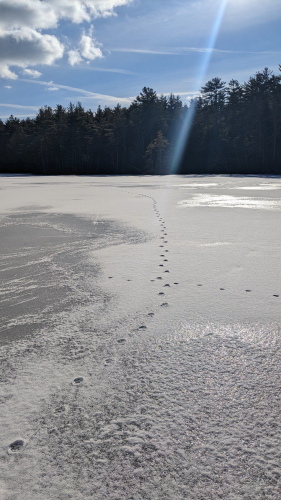People have been reporting sightings of river otters in Meredith Bay the past few days and when I stopped at the town docks yesterday to check on the status of the ice in the bay, there they were - three of them!
 |
| Three river otters right at the end of Meredith Bay. |
 |
| Taken from the Meredith town docks with Pleasant Street in the background, |
They look like three brothers happily carousing together in frigid water - I think I'll name them Mackinnley, Hayden, and Callum. I wish I could frolic endlessly like that in 32 degree water!
We've had several small snowfalls recently which provided enough snow to do a bit of animal tracking and on one trip I observed several sets of tracks including a nice set of bobcat prints in the snow.
 |
| The small spacing of ~6" tells me this cat was walking slowly. |
Right along this same trail I came across this pile of scat which has the size, shape, segmentation, and content of a bobcat:
 |
| Note the fur in this scat. |
 |
| The tail feathers are pressed against the bottom of the feeder; the wings feathers extend down below. |
 |
| A feeder with a long extension on which a pileated woodpecker can press its tail for a third point of support. |
I'll end with two more sets of tracks on Lake Wicwas, which is frozen. I took this picture just because it was pretty but after the fact I wished I paid more attention to the tracks. My best guess is another bobcat based on the round prints and the offset tracks. A coyote or fox would leave prints in a straight line. Had I noted the dimensions I would be able to make a better identification.
Sadly, the ice on Meredith Bay is a long ways from being ready for February's events on the bay, but the otters sure are enjoying the current status.
 |
| The state of ice on Meredith Bay as of yesterday. |
Correction: In last weeks journal entry I misidentified a woodpecker. A knowledgeable viewer noted that the length of the beak and the lack of black spots on the outer tail feathers indicate it was a hairy woodpecker, not a downy. Thank you for that helpful identification information!





Thanks Scott I look forward to your blog every Sunday.🙂
ReplyDelete